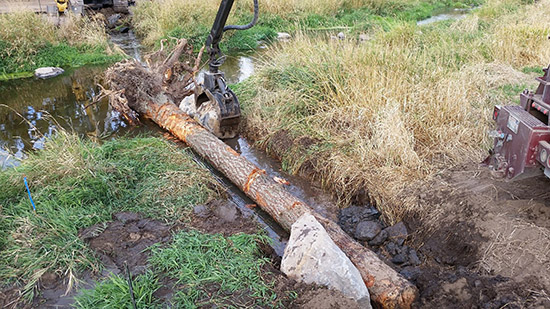|
Subscribe / Renew |
|
|
Contact Us |
|
| ► Subscribe to our Free Weekly Newsletter | |
| home | Welcome, sign in or click here to subscribe. | login |
Construction
| |
 |
January 22, 2018
Best in State: Gold Award
Social, Economic and Sustainable Design
J-U-B Engineers

Project: Pullman-Moscow Regional Airport mitigation
Client: Pullman-Moscow Regional Airport
The Pullman-Moscow Regional Airport's realignment project required a large-scale mitigation effort to compensate for 22 acres of combined wetland and stream impacts at the airport.
Mitigating these impacts in close proximity to the airport was not feasible since wetlands and streams attract wildlife that can be hazardous for airport operations. Because of these restrictions, the airport needed to locate the mitigation property more than two miles away, yet still within the same watershed.
As a subconsultant to Mead & Hunt, the project's primary consultant, J-U-B Engineers, obtained permits, secured land, designed and procured bids, and managed construction in a short six-month turn-around period. The project yielded the largest mitigation site, in terms of area, in eastern Washington.
The site includes the creation of 8 acres of rivertine wetlands, the enhancement of 13 acres of existing rivertine wetlands, the preservation of 91 acres of adjacent and contiguous upland buffer areas, and the installation of thousands of plants, shrubs, trees and boulders.
The mitigation project is unique because it occupies a large, 113.6-acre continuous tract of land, rather than spreading resources between smaller isolated mitigation sites. This utilizes a more holistic approach to wetland and stream mitigation that provides greater habitat diversity and wetland functions.
The establishment of the mitigation site has also resulted in several benefits to the region. The site influenced the creation of companion projects, such as the enhancement of approximately 87 acres adjacent to the site by property owners Tom and Cheryl Kammerzell.
The mitigation site improvements also provided flood storage to those located down-gradient of the project site. After a heavy winter in 2016, the site leveled out the south fork of the Palouse River, dissipating floodwaters and bringing energy out of the river system.
An important component of the success of the mitigation site is biological monitoring and maintenance. J-U-B worked with the airport through its contractor for two years to monitor and maintain the mitigation site, with the airport continuing oversight for eight more years to ensure the native plantings are established and will not need further attention for long-term survival.
Initial monitoring showed favorable performance, except for survival rates for ponderosa pine and Douglas fir plantings, which experienced high mortality rates due to animal browsing and plant installation techniques. By creating a protection system of biodegradable tubes and bamboo stakes around the replacement plantings, the trees bounced back, resulting in a 60.5 percent improvement the following year.
Other Stories:
- National finalist: Platinum Award
Structural Systems
Magnusson Klemencic Associates - National finalist: Gold award
Structural Systems
COWI North America - National finalist: Gold award
Special Projects
Hart Crowser - National finalist: Gold award
Special Projects
Parsons - Best in State: Gold Award
Successful Fulfillment of Client/Owner Needs
GeoEngineers - Best in State: Gold Award
Unique or Innovative Applications
Golder Associates - Best in State: Gold Award
Future Value to Engineering Profession
MIG/SvR - Best in State: Gold Award
Complexity
Stantec - Engineer of the Year


